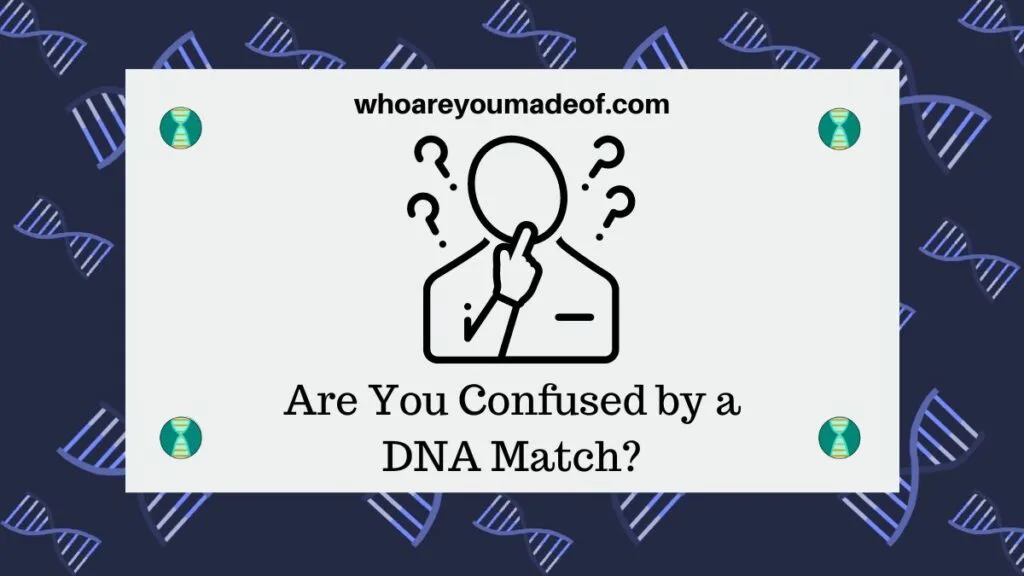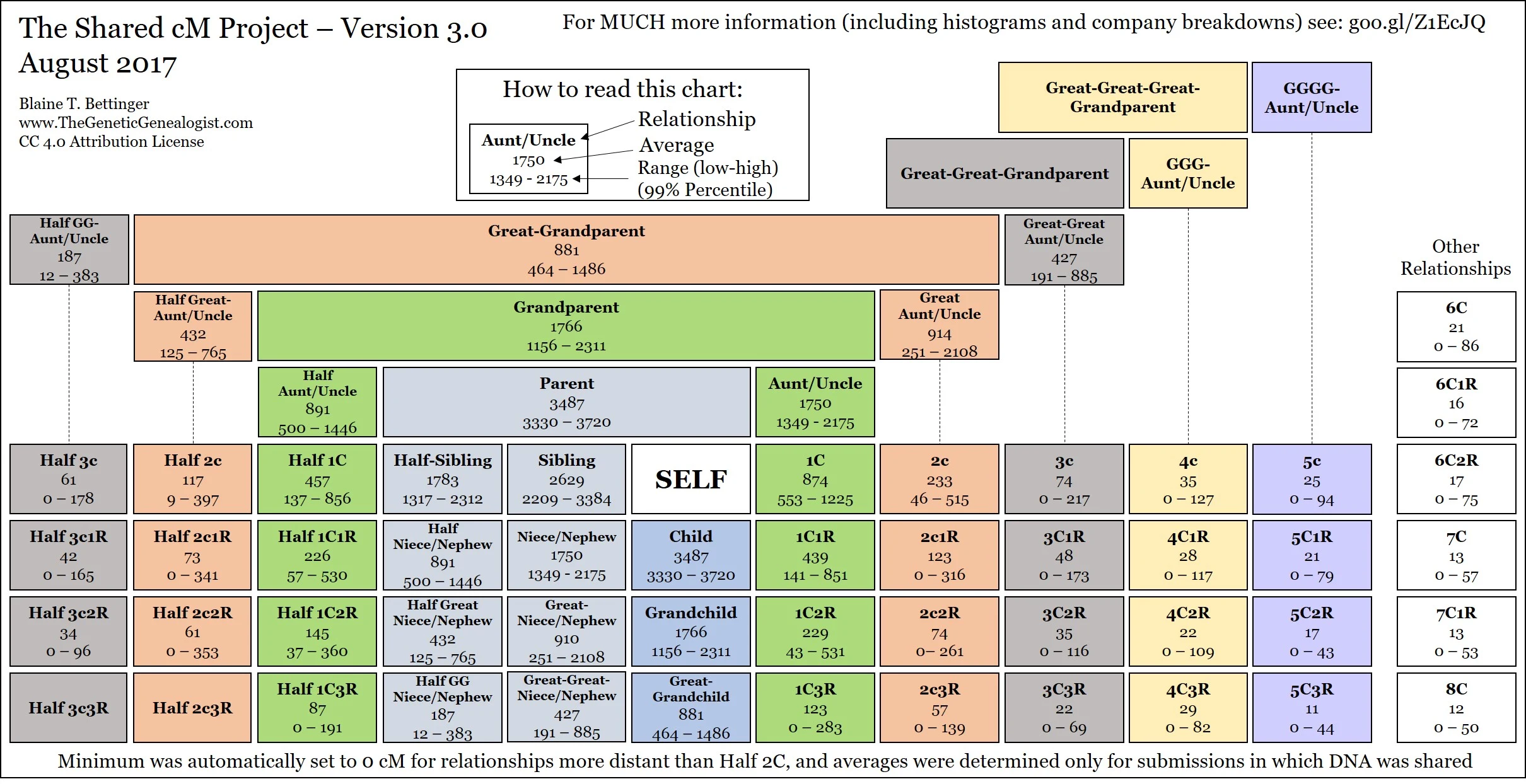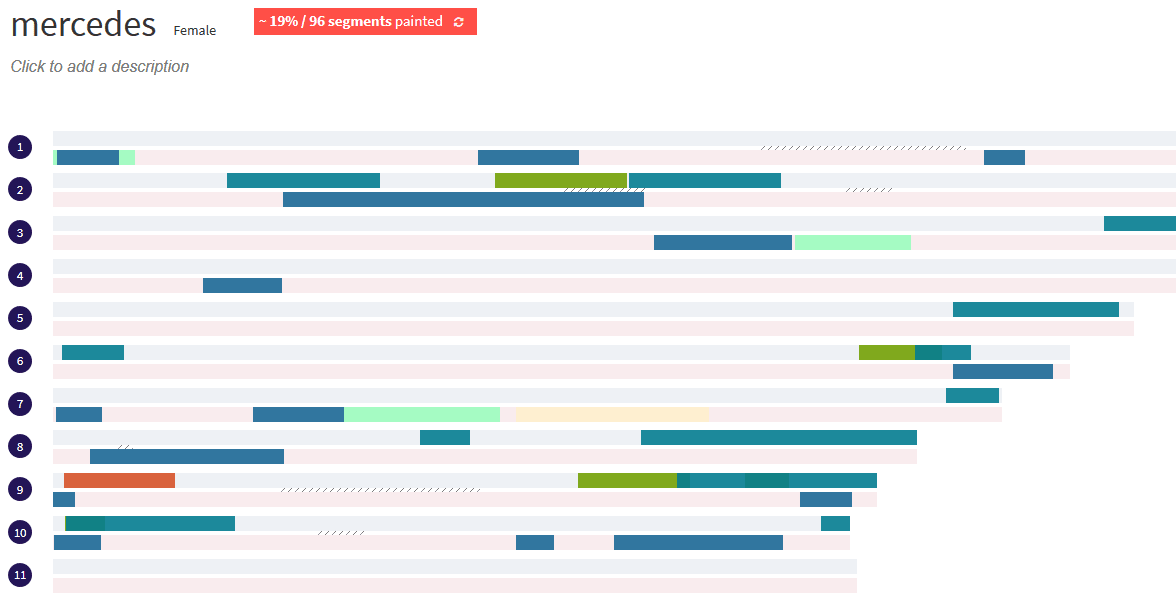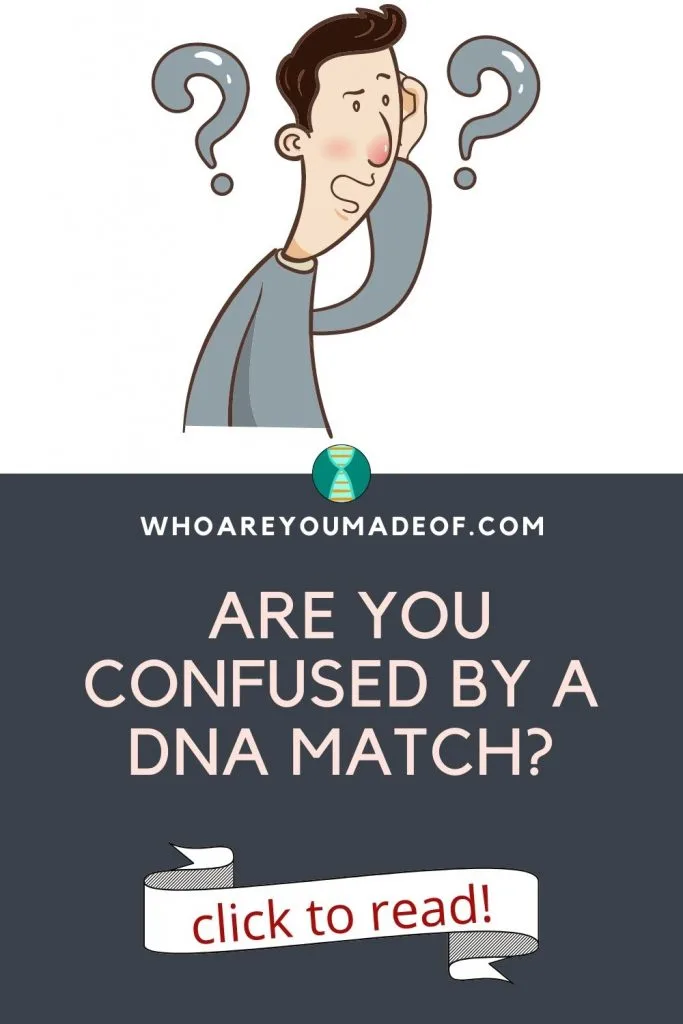Are you confused by a DNA match? In this post, I'll go over some tips and strategies - ranging from the basic to the advanced - to help you figure out your connection.
We all have that one match - trust me. Each time we log in to our results, we can't help but see the match and remember that we haven't been about to figure out how they are related to us.

You will find tips and tricks in this post to help you work out your connection with your match.
Explore total shared DNA amount
The very first thing that you should do when you are confused by a DNA match is determine just exactly how much DNA you share, measured in centimorgans (cMs). Most DNA testing companies provide this information for each match.
For every relationship type, there are normal ranges of shared DNA. The amount of shared DNA can help you eliminate some relationship possibilities. You can use the chart below as an approximate guide:

Let's pretend that I have a DNA match that shares 1200 cMs with me. I can see from the chart that they might be a first cousin, a grandchild, a half-uncle or half-aunt, a half-niece or nephew, a grandparent, or even a great-grandparent.
Depending on what you know for sure about your family, you may be able to eliminate some of these as possibilities.
For example:
- If your match is younger than you, then you know she can't be a grandparent or a great-grandparent
- If neither of your parents have full siblings, then you know that it can't be a first cousin (a half-first cousin will share much less DNA)
- If you haven't had any children (and you are sure... I'm looking at you, gentlemen!) then it can't be a grandchild
It should be noted that the chart above was made using user-submitted data, so I would always recommend verifying your relationship using a few different charts and more traditional methods of genealogical research.
How much does your match share with known relatives?
Have any of your known relatives taken a DNA test? You might be able to find out how much your confusing DNA match shares with these relatives in order to narrow relationship possibilities down a bit).
This section will only apply to you if you have other close relatives that have done a DNA test and have allowed you access to their results. Most people will happily share their results with close family members, so if you know of someone who has tested, make sure to ask politely if they would mind sharing their results with you.
It's totally fine if they say no, however, since there is a lot that you can learn with only your results.
Once you have an idea, based on the shared cMs that you have with your match, you can then check to see how much DNA this person shares with your other relatives. This can help you figure out which line of the family your match is on, and get a better idea of which ancestor you share in common with your match.
We can never tell if our shared DNA is at the bottom or top of the range of shared DNA for our relationship, so seeing how much a person shares with our siblings, aunts, uncles, parents, and grandparents can really help us narrow down the options.
In the example I shared above (a person who shares 1200 cMs with me), if she only shared 900 cMs with my sister, then it eliminates the grandparent or grandchild relationship. If my mother shares 2000 cMs with the match, then I know that the match must be a half-sibling to her - and I have found a new half-first cousin for myself and my sister.
The more data points that you have, the easier it is to narrow down what the possibilities are of a possible relationship.
In my own DNA match list, I had a really confusing match. Well, it wasn't when I saw him on my DNA match that he began to confuse me, since he shows up as about a 4th cousin to me, and since his family tree isn't very complete, I just assumed that we must match further back on one of his lines.
My grandmother did her DNA, and he showed up as her very first 4th cousin match. Then, my grandmother's brother did his test, and he turned out to be a second cousin.
All of this information was so helpful - in fact, I might have ignored this match had it not been for my grandmother and her brother doing a test.
Check longest shared segment data
Most companies, including Ancestry DNA, allow you to see the exact size of your longest DNA segment. It's useful to know this information because it can help you figure out how far back your common ancestor might be.
There are no firm guidelines for how long DNA segments should be for a given relationship, but you can be sure that the longer they are, the closer your relationship. Very long DNA segments (longer than 60 cMs) indicate a very recent ancestor.
Very short segments (like less than 15 cMs) generally indicate a distant ancestor, with some exceptions. Segments that fall in between can be tricky, and could mean anything - so you need to use this information in combination with all of the other data that you are gathering.
More reading on DNA segments:
- DNA segments shared between siblings
- Does a long DNA segment always mean a recent ancestor?
- Example of how DNA segments get smaller over four generations
- Identical by state or coincidentally identical segments
Examine shared DNA matches
Have you checked to see who you share in common with your match? This information can often help you eliminate or determine which line of the family your match falls on. Most DNA testing companies allow you to view shared matches, or matches in common.
If you have had one of your parents test, and your match also matches your parent, then you can be relatively sure that your most recent common ancestor is on that parent's side.
Shared matches are most useful between close relatives (3rd cousins or closer). The way that DNA is inherited makes it less likely that more distant cousins will have many shared matches. Also, we are often related to our distant cousins in more than one way, and shared matches can confuse or mislead us.
Check your DNA match's family tree
Definitely check to see whether your DNA match has posted a family tree on your testing website, or even on another family tree website. I have frequently had good luck typing in "John Joe family tree" into Google to see if they have posted their pedigree on another website - and many times, they have!
If their family tree isn't complete enough for you to spot your common ancestor (maybe they just listed their parents), consider building a family tree for your match to figure out how you are related. It's easier than it sounds, and you will be surprised at how useful it is to do this little trick.
Hey, and while we are talking about this... do you have a family tree? Learn how to build one on Ancestry, it's easy and quick and a good way to keep track of everything you are learning about your family.
Upload your DNA to as many sites as possible
I have occasionally learned more about a DNA match by uploading my DNA results to other websites. Sometimes, they have uploaded theirs, too, and I am able to compare our DNA in other ways (at the chromosome level) or access new/different shared matches that provide me with more information about how we might be connected.
Remember, the idea is to get as much information as possible in order to put the puzzle together.
Some of my favorite sites:
Use a chromosome browser to compare your DNA with your match
Some DNA testing companies offer chromosome browsers where you can see how long all of your shared segments are and which chromosomes they are located on. This information is useful because you can often spot patterns.
For example, if you share a long segment on Chromosome 1 with your paternal first cousin, and your new second cousin matches you on that same chromosome, there is a good chance that the common ancestor that you share with your second cousin is a generation or two back on a line you share with your first cousin.
You might even begin to recognize certain segments. In my own DNA, I have a few mystery segments, and I know just where they are (I'm looking at you Chromosome 8).
The only thing that you have to remember about comparing segments on chromosomes is that we have two copies of each chromosome, one copy from each of our parents.
Since the chromosomes are the same length, we can possibly get confused if we are comparing someone who matches us on a particular chromosome at a particular location with someone else who appears to match at the same segment. It's possible that each match matches on a different copy of the same chromosome.
In order to avoid this confusion, it's best to have some close relatives (parents, grandparents, aunts, uncles, very close cousins) test so you can have some reference points (via shared matches) as to which side of your family a match is on - just to keep the copies of the chromosomes straight. DNA Painter (below) is great for this.
More reading:
Have you been painting your DNA?
This falls under what I would call a more "advanced" tool than some of the things that we have discussed here, but it is a very useful exercise and once you have painted many of your chromosomes, you can usually figure out very quickly on which line a new match is connected.
The tool is called "DNA Painter", and it's totally free. You don't upload or transfer your DNA or anything like that at all. You simply create a new profile for yourself and start painting in matches individually.

I'm about 50% done with my segments now, and I have profiles for my parents, grandmother, and daughter. Now, when they get a new match, all I have to do is open up their profile and find the segment where they match.
Most of the time, I can tell exactly which common ancestor the match shares with the person who I created the profile for, and I know where I should be looking for a common ancestor.
It saves so much time and can really help crack mysteries.

Conclusion
I hope that this post has helped give you some ideas as to how to figure out how your confusing DNA match is related to you. If you follow these tips, you will dramatically increase your "success rate" in determining your connection to your matches, and learn so much more about your family tree.
If you have any questions, comments, or would like to share your own tips, I would love to hear from you below.
Thanks for stopping by!
